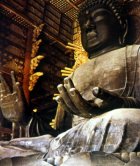Nara Period |
|
|
Similar to the Asuka period, during this period the Japanese relied heavily on outside influences, such as Korea, but predominantly China. Even the Shinto architecture, the traditional Japanese style of architecture, was beginning to be swayed by the influence of Buddhist temple architecture as Buddhism rose to become the main religion of Japan. Both temples and shrines were becoming far more elaborate and decorative than the traditional Japanese architecture where simplicity and natural materials were deemed more expressive. Several factors led to the establishment of large monumental temples during the Nara period. The abundance of wood allowed the Japanese to be overly decorative with the brackets, supports and roofs, but to also create monumental colossal structures. Wealthy patrons provided ample funding for elaborate temples. Construction of temples were further encouraged by the Emperor who wanted to make Buddhism the governing religion of Japan and based in Nara.
|
